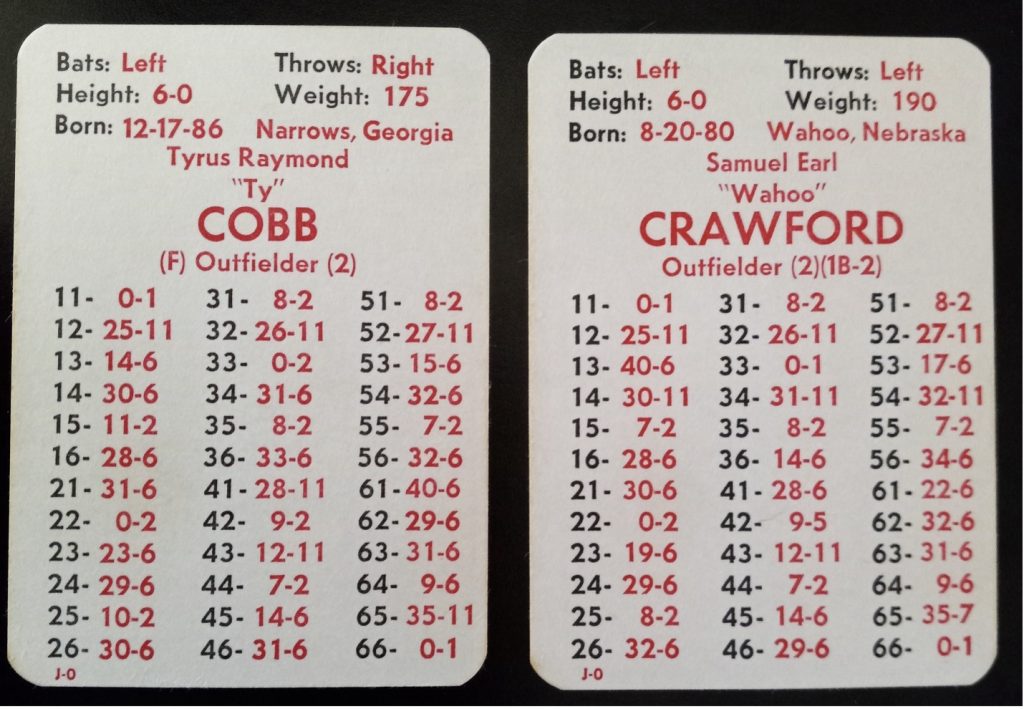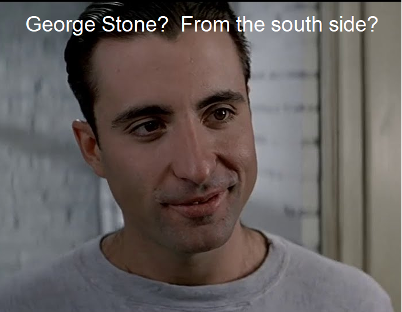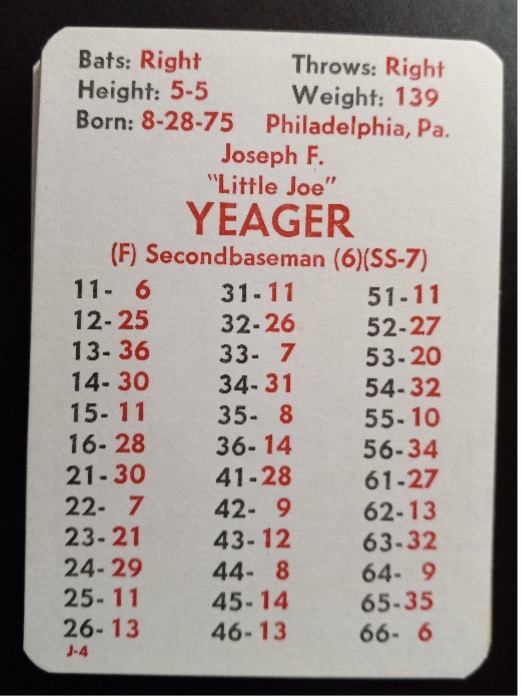As promised by Scott Fennessy in his World Series recap of his 1908 replay, here is his team-by-team summary of the replay.
—
As you can see while my final order was different, it was indeed every bit a 4 team race until the end.
The Red Sox were the leaders with a surprise burst to start the season, but that didn’t last long, as the
Browns took control on May 12th . However, while the Tigers, Indians and White Sox all struggled out of
the gate, they all seemed to be battling for second place as the Browns surprisingly strong pitching
expanded the lead to about 8 games in August and appeared destined for the pennant.
Actual final standings
| Tigers | 90 | 63 |
|---|---|---|
| Indians | 90 | 64 |
| White Sox | 88 | 64 |
| Browns | 83 | 69 |
| Red Sox | 75 | 79 |
| A’s | 68 | 85 |
| Senators | 67 | 85 |
| Yankees | 51 | 103 |
My final standings
| Tigers | 85 | 55 |
|---|---|---|
| Browns | 83 | 57 |
| Indians | 82 | 58 |
| White Sox | 81 | 59 |
| Senators | 64 | 76 |
| Red Sox | 63 | 77 |
| A’s | 57 | 83 |
| Yankees | 45 | 95 |
Unfortunately for St. Louis, the other three never gave up, and eventually Detroit’s hitting woke up
about this time, and the Browns pitching began to run out of gas and while it appeared that they waited
too long to begin the pursuit, they finally caught up with them in early September, and passed them on
the 19 th and finally clinched the AL flag on September 28. The Browns never recovered, but still held on
to second for an impressive, yet ultimately disappointing end to a solid year.
Ty Cobb – DET
American League MVP
- .272 AVG
- 5 HR
- 59 RBI
- 31 SB
Ed Walsh – CWS
American League Pitcher of the Year
- 32-17
- 1.12 ERA
- 12 shutouts
- one no-hitter
Detroit Tigers
85-55 First place
Detroit was my pick to win when going through all the cards before I started the season. Solid pitching
and just enough hitting once you got past the small core of players. The only real problem was their defense, while fielding two overall had some players that were individually fielding three and that cost
them some games.
Herman Schaefer (.270 4 HR 33 SB) had a much better season than I expected. But was sometimes a
problem defensively.
Detroit had what I expected to be the best dead ball 1-2 combo in history, and while they put together a
good/decent combo, I feel they underperformed.
Cobb (.272 5 HR 31 SB) got off to a terrible start as Schaeffer missed a lot of time early, and resulting in him not being able to execute the hit and run like I wanted to with this lineup. He recovered nicely about the end of May got better as the year went on while piling up a ton of extra base hits and steals in route to winning the MVP award.
Sam Crawford (.249 7 HR 78 RBI) never got untracked. He would occasionally flirt with .270, but would then go several hitless games. This was probably the most underperforming card of the year. Unfortunately, the rest of the lineup was not very helpful and had to rely on pitching to carry them the rest of the way.
Rookie Oren Summers (21-11 1.67 ERA .79 WHIP), Bill Donovan 18-10 1.69 ERA .72 WHIP) and George Mullin (19-11 2.69 ERA) were the anchors of the team. Robert Willett (12-11) and Ed Siever (6-3) chipped in some gritty performances late in the year.
St Louis Browns
(83-57 3 games behind)
The little engine that couldn’t had a fantastic year, especially compared to previous replays, but in the end choked away a big lead and will have to wonder how they will recover going forward.
With a 2-1 win over Cleveland on May 19th they moved into first. Despite not having much in the way of hitting got a lot of clutch hits to win games that were backed up by a strong pitching staff. They slowly expanded the lead as the summer wore on, but eventually the pitching staff tired from carrying the load about the same time Cobb carried the Tigers on his back and built what appeared to be a comfortable 8 game lead by August.
They continued to fade in September, and lost a critical 5 game series in Detroit that cut the lead dramatically and were never the same. They gave up the lead they had held for so long on the 19th and were forced to hold off a ferocious challenge from both the Indians and White Sox to barely hang on to second place.
Like most teams, St. Louis relied on the top of the order to provide most of the offense. Roy Hartzell (.246 4 HR 40 SB) was the table setter most of the year. Bobby Wallace (.244) had a bit of a comeback with his best performance in 3 seasons. George Stone (.306 6 HR 60 RBI) was the lone .300 hitter in the AL and won his second consecutive batting championship he was steady in most categories and finished in second place in the MVP voting behind Cobb by just 3 votes.
Rookie Albert Schweitzer (.262 1 HR 9 SB) only played 63 games, but provided middle of the order support that kept St. Louis afloat longer than they might have. Had he been available earlier they might have hung on.
What a difference a few years makes. In my 1901 replay “Little Joe” Yeager was a C starting pitcher for the Brewers. A few years later he became an infielder. He only played in 8 games and hit .387 with 7 stolen bases. Unfortunately, he retired at the end of the season, so this is his final card.
Hobe Ferris came over from Boston and moved from second base to third, where he performed significantly better than expected, earning his 3B 5 rating. He also hit a career high 5 homers, which was something they were pretty good at as a team, leading the AL with 25.
While their hitting may have been little thin, their pitching was very good. The staff was anchored by Rube Waddell (22-14 1.67 ERA) and surprise star Harry Howell (22-10 1.73 ERA). Harry has been around for several seasons now, and has always had good/very interesting cards, but this year he simply performed better than expected. Four of his six shutouts for the season came in consecutive starts for a new record.
Although he didn’t have the blazing fastball of Waddell, he was strong at controlling the zone and had a devastating spitball that induced a lot of groundouts. John Powell (19-13 1.92 ERA) was very effective during the middle of the season.
The remainder of the bullpen was decent, and was not the usual collection of guys who couldn’t get anyone out, and that was part of the reason that despite the late collapse, they didn’t fall past second place.
Cleveland Indians
(82-58 4 1/2 games behind)
Cleveland is a team in transition, and other than Napoleon Lajoie do not have much in the way of hitting. Speaking of Lajoie, he got off to his third straight year with a bad start, and had to work hard to get the bat moving, and then he started hitting tons of doubles and triples.
He had a strong chance at the MVP, finishing at .280 with 36 doubles and 7 triples. Age is catching up at last as he didn’t hit any homers and had only 13 steals.
With Cotton Turner (.222 AVG 22 SB) missing a significant part of the season Joshua Clarke was inserted into the leadoff spot. He struggled mightily hitting the ball, finishing with a disappointing .217 average, but he showed a pretty strong knowledge of the strike zone, drawing 66 walks, and once on first second base was almost a given as evidenced by his 47 stolen bases. It was his speed that unlocked the power of Lajoie’s four 31’s.
Too bad catcher Jay Clarke missed so much time this season, because he would have qualified for the top ten in batting, finishing at .276 with 3 HR in 97 games.
The pitching on this team was so deep that it was able to overcome the worst hitting Indians team in 7 years. Led by the immortal Addie Joss (26-9 1.07 ERA .69 WHIP) the losing streaks were kept short. Glenn Liebhardt (14-12 1.75 ERA) was crucial down the stretch, where he had his best run of the season.
Robert Rhoades (18-12 1.93 ERA), Charles Berger (10-14 1.68 ERA) who was the pitcher who lost most of the one run games, and Charlie Chech (9-7) ate a lot of innings. Ed Foster only appeared in 2 games all year, had a 6.82 ERA, but managed to get the only save in all of baseball.
Chicago White Sox
(81-59 6 games behind)
The bad news is the Sox still can’t hit. The good news is they finally have a couple of players who cleared the Mendoza line, and for the first time in 2 years the team batting average (.203) was higher than the teams ERA (1.83)
When they do manage to get on base stealing is the top priority as their 247 stolen bases was easily first in the AL. Manager Fielder Jones (.263 54 SB) tried to lead by example, and had his best results in 4 years.
Pat Dougherty (.243 46 SB) was a strong enough bat behind Jones to provide something resembling offense. “Honest John” Anderson hit .217 in a little over 100 games and John Donahue hit .205 in 56 games. That was the extent of anything that could be called hitting.
Thankfully for Jones, his pitching staff was solid and could literally go the distance. While they carried 7 pitchers in total, it really came down to their “big three” of Ed Walsh (32-17 1.12 ERA .64 WHIP 12 shutouts), Frank Smith (22-13 1.67 ERA) and Doc White (22-15 2.08 ERA)
Even then Walsh literally put the team on his back over the final two weeks, pitching nearly every game on his way to 49 complete games and 466.2 innings. Smith helped himself, and was more competent at the plate than the 7 and 8 hitters in front of him. Smith hit .235 with 13 doubles on the season. The other pitchers that saw work were a scattering of surprisingly good or really awful.
Washington Senators
(64-76 31 1/2 behind)
You wouldn’t know it by looking at the standings, but this was a pretty awful Sens team. They had the lowest team fielding rating in the history of my replays. They had exactly ONE starter rated above fielding 3.
Yet somehow, they only committed 177 errors, which was not even close to the 258 the 1905 Browns botched. The hitting was exceptionally bad, not even hitting the .190 mark as a team. Only two players cleared that mark, and both of them were part timers.
James Delahanty was easily the star of the DC show, hitting .312 with 25 extra base hits, including a team high 3 homers, and finished 3rd in steals with 30 in just 82 games.
Jesse Milan hitting .201 was the only other regular to clear that line. Utility man, and former Red Sox manager Bob Unglaub came over and hit .271 in 55 games.
Although the pitching wasn’t exactly world class, it had some potential. Led by veteran Tom Hughes (18-13 1.61 ERA) and 21 year old Walter Johnson (14-15 1.79 ERA) in his first full season, things seem like they may improve in the future. Unfortunately, history says otherwise, but the DC faithful have at least one player to build around.
Charles Smith (10-13 2.43 ERA) and William Burns (8-11 2.22 ERA) performed admirably. Too bad the remaining pitchers were either rookies, or washed up veterans and didn’t do much to help the team.
Boston Red Sox
(63-77 33 games behind)
When the AL first formed, they basically stole the Braves entire lineup. This gave them instant success in the early years, but here we are, 7 years later, and they are now paying a heavy price for that.
Only 2 players remain from that team, Cy Young, and the first “personal catcher” in history Lou Criger. This team is easily the worst bosox team I have replayed so far, with terrible defense, almost no hitting, and once you get past Young, not much pitching either.
I try to remain neutral, but I was kind of pulling for Henry Gessler. Henry hasn’t had much success in his career, but finally cracked a starting lineup for the first time in five years.
He was hitting over .300 until about the final month of the year and although he limped to the finish, but easily had the best year of his career, hitting .288 with 3 home runs and 42 stolen bases. Only Charles Wagner (.244) hit higher than .210.
Cy Young (19-16 1.68 ERA) didn’t have much support, but still had a solid year. He also hit .242 at the plate, which was better than most of his teammates.
Harry Morgan, the pitcher, not the guy who played Col. Potter went 14-14 with a 1.77 ERA, but like all Boston hurlers, lacked the support to have a bigger season.
Rookie Eddie Cicotte (12-15) and Elmer Steele (9-5) had solid moments throughout the season as well, but the remaining pitchers had an ERA approaching 4.00 and were mostly used in blowouts.
Philadelphia A’s
(57-83 42 games behind)
The A’s are in the early stages of the rebuild. A couple years removed from being a top team, they don’t have much, but the beginnings of the $100,000 infield are arriving.
Eddie Collins played over 100 games for the first time in his career, and disappointed greatly, hitting just .153 with 14 SB. Jack Barry played just 39 games on an injury riddled team and hit just .165.
Jasper Davis is finally slowing down with age, but was the best hitter on the team, despite disappointing overall by hitting .228 with 1 homer. Yet his lowly batting average was by far the highest on the team, as were his 30 stolen bases.
The pitching also had a lot of new faces this year, with only Eddie Plank (11-15 1.71 ERA), James Dygert (7-21) and Chief Bender (6-11) returning from last year’s squad. Harry Vickers (25-9 1.79 ERA) was easily the ace of a staff that didn’t do much on the mound to talk about.
New York Yankees
(45-95 60 games behind)
To say this team was awful is an understatement. Most of the team underperformed, and it showed in the standings. Charlie Hemphill (.243 58 SB) was the leader on an extremely lackluster offense.
Willie Keeler (.268 2 HR 21 SB) spent almost half the season on the disabled list with a shoulder injury suffered during the offseason, but the team finally started to score once he joined the lineup.
Other than Hemphill, George Moriarity (.214 25 SB) was the only other regular who cleared the .200 line among the regulars, with James O’Rourke (.236) and Earl Gardner (.232) providing something resembling help off the bench.
Considering how incredibly overpowering pitching was during this season, the Yankees 3.77 team ERA was almost a full run worse than eveyone else in the league, which is saying a lot, and when combined to a terrible lineup all but guaranteed them a last place finish.
Not one pitcher had a winning record, and only Jack Chesbro (15-18 2.97 ERA) and Walter Manning (7-10 2.40 ERA) had ERA’s under 3.
Hang on NY fans, it is only 11 years until the Babe arrives.
—
Fantastic recap! Congrats on completing your replay, Scott!







Seems odd for Cobb to hit .272.
Well, first you have to remember, that almost every game was against an A starter. Lots of hit and run rolls were double plays, 7’s in a situation where the A wiped them out, and an unfortunately long string of bad rolls in the first month and a half to open the season didn’t help.
To better put this in perspective, there was exactly ONE hitter in the entire league that hit .300, and that was because when he rolled on the hit and run it always seemed like a 15-11 or result of 31 popped up. However, once Cobb did start hitting, he probably added about 70 points to his average in the second half.
He may have underperformed pretty badly, but he was still better than 80% of the AL.
I did a 1908 AL replay back in the 1980’s. The second edition of the Master Game came out right at the half way point of the season so half was played with the original MG and the other half with the updated version. My standings:
DET 96-58 .622 –
STB 63-61 .604 3
CLE 87-67 .565 9
CHW 86-68 .558 10
BRS 73-81 .474 23
WSH 70-84 .455 26
PHA 66-88 .429 30
NYH 45-109 .292 51
Cobb hit .322 5 HR 111 RBI 41 SB
Walsh was 37-12 3 SV 13 SHO 1.07 ERA
It was nice to see another rendition of what is one of my favorite seasons. I was sorry I never got a chance to do the National League.